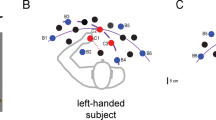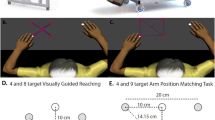Abstract
We report the use of a mechatronic device for assessing arm movement impairment after chronic brain injury. The device, called the “Assisted Rehabilitation and Measurement Guide,” is designed to guide reaching movements across the workspace, to measure movement and force generation, and to apply controlled forces to the arm along linear reaching paths. We performed a series of experiments using the device in order to identify the contribution of active muscle and passive tissue restraint to decreased active range of motion of guided reaching (i.e., “workspace deficits”) in a group of five chronic, spastic hemiparetic, brain-injured subjects. Our findings were that passive tissue restraint was increased in the spastic arms, as compared to the contralateral, nonparetic arms. Active muscle restraint, on the other hand, was typically comparable in the two arms, as quantified by measurements of active arm stiffness at the workspace boundary during reaching. In all subjects, there was evidence of movement-generated weakness, consistent with a small contribution of spasticity to workspace deficits. These results demonstrate the feasibility of mechatronic assessment of the causes of decreased functional movement, and could provide a basis for enhanced treatment planning and monitoring following brain injury. © 1999 Biomedical Engineering Society.
PAC99: 8719La, 8719St, 8780Vt, 8719Nn, 8719Ff
Similar content being viewed by others
REFERENCES
Aisen, M. L., H. I. Krebs, N. Hogan, F. McDowell, and B. T. Volpe. The effect of robot-assisted therapy and rehabilitative training on motor recovery following stroke. Archives of Neurology 54:443–445, 1997.
Ashworth, R. W. Preliminary trial of carisoprodaol in multiple sclerosis. Practitioner 192:540–542, 1964.
Billian, C., and G. I. Zahalak. A programmable limb testing system (and some measurements of intrinsic muscular and reflex-mediated stiffnesses). J. Biomech. Eng. 105:6–11, 1983.
Corcos, D. M., G. L. Gottlieb, R. D. Penn, B. Myklebust, and G. C. Agarwal. Movement deficits caused by hyperexcitable stretch reflexes in spastic humans. Brain 109:1043–1058, 1986.
Craig, J. J. Introduction to Robotics: Mechanics and Control, 2nd ed. New York: Addison-Wesley, 1989.
Delagi E. F., and A. Perotto. Anatomic Guide for the Electromyographer, 2nd ed. Springfield, IL: C. C. Thomas, 1980.
Desrosiers, J., D. Bourbonnais, G. Bravo, P. M. Roy, and M. Guay. Performance of the 'unaffected' upper extremity of elderly stroke patients. Stroke 27:1564–1570, 1996.
Dewald, J. P. A., P. S. Pope, J. D. Given, T. S. Buchanan, and W. Z. Rymer. Abnormal muscle coactivation patterns during isometric torque generation at the elbow and shoulder in hemiparetic subjects. Brain 118:495–510, 1995.
Dietz, V., J. Quintern, and W. Berger. Electrophysiological studies of gait in spasticity and rigidity. Brain 104:431–449, 1981.
Dietz, V., M. Trippel, and W. Berger. Reflex activity and muscle tone during elbow movements in patients with spastic paresis. Ann. Neurol. 30(6):767–779, 1991.
Fellows, S. J., C. Kaus, H. F. Ross, and A. F. Thilmann. Agonist and antagonist EMG activation during isometric torque development at the elbow in spastic hemiparesis. Electroencephalogr. Clin. Neurophysiol. 93:106–12, 1994.
Fellows, S. J., C. Kaus, A. F. Thilmann. Voluntary movement at the elbow in spastic hemiparesis. Ann. Neurol. 36(3):397–407, 1994.
Fugl-Meyer, A. R., L. Jaasco, L. Leyman, S. Olsson, and S. Steglind. The poststroke hemiplegic patient. Scand. J. Rehabil. Med. 7:13–31, 1975.
Given, J. D., J. P. A. Dewald, and W. Z. Rymer. Joint dependent passive stiffness in paretic and contalateral limbs of spastic patients with hemiparetic stroke. J. Neurol., Neurosurg. Psychiatry 59:271–279, 1995.
Goldspink, G., and P. E. Williams. Muscle fibre and connective tissue changes associated with use and disuse. In: Foundations for Practice: Topics in Neurological Physiotherapy, edited by L. Ada and C. Canning. London: Heinemann, 1990 pp. 197–218.
Gomi, H., and R. Osu. Task-dependent viscoelasticity of human multijoint arm and its spatial characteristics for interaction with environments. J. Neurosci. 18(21):8965–8978, 1998.
Gresham G. E., P. W. Duncan, and W. B. Stason. Post-Stroke Rehabilitation. Rockville, MD: U.S. Dept. Health and Human Services, Agency for Health Care Policy and Research; 1995.
Hammond, M. C., S. S. Fitts, G. H. Kraft, P. B. Nutter, M. J. Trotter, and L. M. Robinson. Co-contraction in the hemiparetic forearm: quantitative EMG evaluation. Arch. Phys. Med. Rehabil. 69:348–51, 1988.
Hufschmidt, A., and K.-H. Mauritz. Chronic transformation of muscle in spasticity: a peripheral contribution to increased tone. J. Neurol., Neurosurg. Psychiatry 48:676–685, 1985.
Lee, W. A., A. Boughton, and W. Z. Rymer. Absence of stretch reflex gain enhancement in voluntarily activated spastic muscle. Exp. Neurol. 98:317–335, 1987.
Lum, P. S., C. G. Burgar, D. Kenney, and H. F. M. Van der Loos. Quantification of force abnormalities during passive and active-assisted upper-limb reaching movements in poststroke hemiparesis. IEEE Trans. Biomed. Eng. 46(6):652–662, 1999.
Magnusson, S. P. Passive properties of human skeletal muscle during stretch maneuvers. A review. Scand. J. Med. Sci. Sports 8(2):65–77, 1998.
Morgan, D. L. Separation of active and passive components of short-range stiffness of muscle. Am. J. Physiol. 232(1):C45–9, 1977.
O'Dwyer, N. J., L. Ada, and P. D. Neilson. Spasticity and muscle contracture following stroke. Brain 119:1737–1749, 1996.
Powers, R. K., D. L. Campbell, and W. Z. Rymer. Stretch reflex dynamics in spastic elbow flexor muscles. Ann. Neurol. 25:32–42, 1989.
Reinkensmeyer, D. J., J. P. A. Dewald, and W. Z. Rymer. Robotic devices for physical rehabilitation of stroke patients: Fundamental requirements, target therapeutic techniques, and preliminary designs. Technology and Disability 5:205–215, 1996.
Reinkensmeyer, D. J., N. Hogan, H. I. Krebs, S. L. Lehman, and P. S. Lum. Rehabilitators, robots, and guides: New tools for neurological rehabilitation, Biomechanics and Neural Control of Movement, edited by Jack Winters and Pat Crago New York: Springer, 1999, in press.
Reinkensmeyer, D. J., and W. Z. Rymer. Using a mechanical guide to evaluate and treat workspace deficits after brain injury. Proceedings of the 19th Annual IEEE Engineering in Medicine and Biology Sociey Conference 1997.
Reinkensmeyer, D. J., B. D. Schmit, and W. Z. Rymer. Arm stiffness at the active workspace boundary in spastic hemiparesis. Soc. Neurosci. Abstracts 24:1664, 1998.
Reinkensmeyer, D. J., J. P. A. Dewald, and W. Z. Rymer. Guidance based quantification of arm impairment following brain injury: A pilot study. IEEE Trans. Rehabil. Eng. 7(1):1–11, 1999.
Sinkjaer, T., and I. Magnussen. Passive, intrinsic, and reflex-mediated stiffness in the ankle extensors of hemiparetic patients. Brain 117:355–363, 1994.
Thilmann, A. F., S. J. Fellows, H. F. Ross. Biomechanical changes at the ankle after stroke. J. Neurol., Neurosurg. Psychiatry 54:134–9, 1991.
Author information
Authors and Affiliations
Rights and permissions
About this article
Cite this article
Reinkensmeyer, D.J., Schmit, B.D. & Rymer, W.Z. Assessment of Active and Passive Restraint During Guided Reaching After Chronic Brain Injury. Annals of Biomedical Engineering 27, 805–814 (1999). https://doi.org/10.1114/1.233
Issue Date:
DOI: https://doi.org/10.1114/1.233




